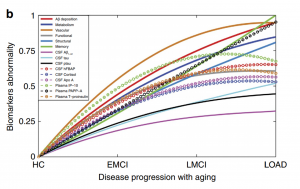Biomarkers: the key to the investigation of pre-symptomatic AD
Pre-symptomatic AD cannot be investigated by only relying on clinical symptoms. Instead, we need other indicators to reveal the development of the biological process. These indicators are called biomarkers. They may include changes in neuroimaging results as well as in the chemistry of cerebrospinal fluid (CSF) or other body fluids (figure below). The study of AD biomarkers will provide the best chance of advancing knowledge on the AD pathogensis and possible target for AD prevention.
The Prevent-AD Program investigates the following biomarkers:
- Brain Imaging:
- Magnetic Resonnance Imaging (MRI): volumes of brain structures, cortical thickness, connectivity, synchronicity of electric signals, grey matter density, integrity of fibres, blood flow, brain activity at rest and during a memory task.
- Positrons Emission Tomography (PET): Amyloid and Tau tracers
- Magnetoencephalography (MEG): Collaboration with Dr. Sylvain Baillet
- Cerebrospinal Fluid
- Amyloid beta, tau, cytokines, albumin
- Lumbar puncture research technique video
- Neurosensory Testing
- Central Auditory Processing, Odor identification
- Spatial Orientation & Navigation
- Collaboration with Veronique Bohbot
- Cognitive Measures
- MoCA, CDR, RBANS, more
- Studies of risk factors
- Pharmacological profile, medical history, lifestyle, sleep, physical activity, hobbies, diet habits, blood pressure, blood & urine analysis
Figure: Data-driven model from Iturria-Medina et al., 2015 to represent the progression of biomarkers abnormality from healthy controls (HC), through early Mild Cognitive Impairment (EMCI), late MCI, and towards the late onset Alzheimer Disease (LOAD).
